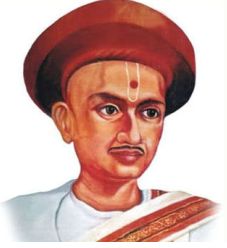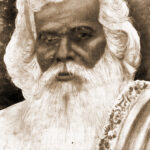Balshastri Jambhekar: 5 Remarkable Contributions to the Marathi Renaissance and Indian Society
Balshastri Jambhekar, a renowned scholar, social reformer, and writer, was one of the most influential figures during the Marathi Renaissance and played a key role in shaping the cultural and educational landscape of 19th-century India. Often hailed as the “Father of Marathi Journalism,” his intellectual contributions in various fields, including literature, history, and social reforms, have left an indelible mark on the development of modern Maharashtra.
Early Life and Influences
Born in 1812 in a small village in Maharashtra, Balshastri Jambhekar grew up during a period when India was under British rule. The societal structure was rigid, with traditional practices and customs influencing every aspect of daily life. However, Jambhekar’s curiosity and passion for knowledge were nurtured early in life. He was educated in Sanskrit, Marathi, and other languages and grew up with a deep understanding of the social and intellectual issues of the time.
Shaped by the Enlightenment ideals and Western education, Jambhekar was exposed to new thoughts about social reform and cultural revival. He became deeply influenced by the works of social reformers and scholars, particularly those who challenged traditional views and worked for progress and modernization.
Key Contributions to Indian Society
Balshastri Jambhekar is best known for his contributions to the Marathi Renaissance and his pioneering role in the fields of journalism, literature, and social reform. Below are five remarkable contributions he made to society:
- Founding of the First Marathi Newspaper: One of Jambhekar’s most significant contributions was the establishment of the first Marathi-language newspaper, “Dnyanodaya” (The Rise of Knowledge) in 1842. This marked the beginning of modern Marathi journalism, enabling the spread of new ideas, educational reforms, and social awareness. The paper served as a platform to discuss various issues affecting Indian society, ranging from colonial rule and social inequality to education and women’s rights.
- Promotion of Marathi Literature: Balshastri Jambhekar was a pioneer in the development of modern Marathi literature. He made significant contributions to the literary heritage of Maharashtra by introducing new forms of writing and developing Marathi prose. Jambhekar’s writings, particularly his essays, were instrumental in shaping public opinion and stimulating intellectual discourse in the region. He is considered one of the earliest proponents of literary modernization, as he emphasized clarity, rationality, and logic in literary works.
- Advocacy for Education and Knowledge: Jambhekar was deeply committed to the idea of education as the means for social and intellectual progress. As a strong advocate for education, especially for women, he pushed for the reform of the traditional education system. Through his writings, he stressed the importance of modern education, scientific learning, and the need to move beyond outdated practices that hindered social development. Jambhekar worked closely with other reformers to spread the idea of education for all, regardless of caste, class, or gender.
- Social Reform and Criticism of Caste System: Balshastri Jambhekar was an outspoken critic of the caste system and the rigid social structure that marginalized lower castes and untouchables. His views on social equality and his advocacy for breaking the caste barriers were ahead of his time. He firmly believed in the value of every individual and emphasized the importance of human dignity, rights, and justice. He encouraged people to challenge the caste-based discrimination that was prevalent in Indian society.
- Influence on Other Social Reformers: Jambhekar’s work and ideas had a profound influence on other prominent social reformers, including Jyotirao Phule and Dr. B.R. Ambedkar. His contributions to the Marathi Renaissance helped lay the foundation for the growth of intellectual and social movements that later focused on empowering the downtrodden and marginalized communities in India. His efforts in promoting education and social equality inspired a generation of thinkers who continued to fight for progressive social change.
Daily Life and Legacy
Balshastri Jambhekar led a disciplined and intellectual life, dedicated to advancing knowledge and social reform. His daily routine revolved around writing, studying, and engaging in public discussions. He often spent long hours researching and translating foreign texts, working tirelessly to create a modern, rational, and progressive body of knowledge for the Marathi-speaking population.
His legacy is not only preserved in his writings but also in the progressive changes he helped usher in within Marathi society. He laid the groundwork for future generations of writers, journalists, and reformers who sought to bring about a more just and educated society.
Significance of Balshastri Jambhekar in Society
Balshastri Jambhekar’s significance lies in his pioneering role in the social and intellectual awakening of Maharashtra during the 19th century. His efforts to modernize Marathi literature, establish journalism as a tool for social change, and advocate for education and social equality played a vital role in shaping modern Indian society. His contributions to the Marathi Renaissance were instrumental in the development of a progressive and enlightened society in India.
Jambhekar’s efforts also contributed to the formation of a new public sphere in India, one where issues such as education, caste discrimination, and social equality could be discussed openly. His legacy continues to inspire social reformers, writers, and intellectuals who seek to foster progressive thought and social justice in India.
FAQs About Balshastri Jambhekar
1. What was Balshastri Jambhekar known for?
Balshastri Jambhekar was known for his pioneering work in Marathi journalism and literature. He is regarded as the “Father of Marathi Journalism” and played a key role in the Marathi Renaissance by advocating for social reform, education, and the abolition of caste discrimination.
2. What was the significance of Dnyanodaya?
Dnyanodaya, founded by Jambhekar in 1842, was the first Marathi newspaper and played a significant role in spreading modern ideas, encouraging social reform, and discussing important issues like education, women’s rights, and caste discrimination.
3. How did Balshastri Jambhekar contribute to Marathi literature?
Jambhekar contributed to Marathi literature by developing modern Marathi prose, emphasizing clarity and rationality in writing. His essays and writings were influential in shaping public discourse and promoting intellectual growth in Maharashtra.
4. What was Jambhekar’s stance on the caste system?
Jambhekar was a vocal critic of the caste system. He believed in social equality and human dignity and worked to challenge the discrimination faced by lower castes and untouchables. His views on social equality contributed to the broader social reform movements in India.
5. How did Balshastri Jambhekar influence social reformers like Jyotirao Phule and Dr. B.R. Ambedkar?
Jambhekar’s ideas and contributions had a profound influence on later social reformers such as Jyotirao Phule and Dr. B.R. Ambedkar. His advocacy for education, social equality, and the abolition of caste-based discrimination provided a foundation for their own work in social reform and the upliftment of marginalized communities.
Conclusion
Balshastri Jambhekar’s contributions to Marathi literature, journalism, and social reform were groundbreaking and transformative for Indian society. His work in promoting education, challenging social inequalities, and fostering intellectual progress laid the groundwork for the Marathi Renaissance and inspired generations of thinkers and reformers. As the “Father of Marathi Journalism,” Jambhekar played an instrumental role in shaping the modern intellectual landscape of Maharashtra and India. His legacy continues to influence social movements and intellectual pursuits today.











Nicely put, Cheers.
You suggested that exceptionally well.